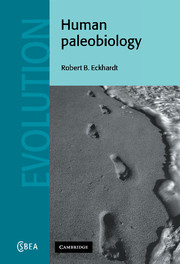Book contents
- Frontmatter
- Contents
- Preface
- Acknowledgments
- 1 Paleobiology: present perspectives on the past
- 2 Constancy and change: taxonomic uncertainty in a probabilistic world
- 3 A century of fossils
- 4 About a century of theory
- 5 Human adaptability present and past
- 6 Primate patterns of diversity and adaptation
- 7 Hominid phylogeny: morphological and molecular measures of diversity
- 8 Plio-Pleistocene hominids: the paleobiology of fragmented populations
- 9 Character state velocity in the emergence of more advanced hominids
- 10 The paleobiology of widely dispersed hominids
- 11 Paleobiological perspectives on modern human origins
- 12 A future for the past
- Bibliography
- Index
4 - About a century of theory
Published online by Cambridge University Press: 18 December 2009
- Frontmatter
- Contents
- Preface
- Acknowledgments
- 1 Paleobiology: present perspectives on the past
- 2 Constancy and change: taxonomic uncertainty in a probabilistic world
- 3 A century of fossils
- 4 About a century of theory
- 5 Human adaptability present and past
- 6 Primate patterns of diversity and adaptation
- 7 Hominid phylogeny: morphological and molecular measures of diversity
- 8 Plio-Pleistocene hominids: the paleobiology of fragmented populations
- 9 Character state velocity in the emergence of more advanced hominids
- 10 The paleobiology of widely dispersed hominids
- 11 Paleobiological perspectives on modern human origins
- 12 A future for the past
- Bibliography
- Index
Summary
Introduction
The preceding chapter covered the mid-1820s to the mid-1920s, the period in which representatives of the major stages or grades of hominid evolution were discovered. Now we turn our attention to the events of the twentieth century. These events, however, in reality began with the publication of The Origin of Species by Charles Darwin in 1859 and which in many areas of paleontology, continue through to the present. Research in areas as diverse as developmental biology and field ecology were stimulated strongly by Darwin's publication.
Work along these many lines, and more, continues at a high rate. However, what might be considered an interim status report was provided by the publication in 1942 of Evolution, the Modern Synthesis. Janus-like, this volume by Julian Huxley surveyed the great strides that had been made since Darwin's work, and looked forward to the nascent expansion in fields such as ecological and biochemical genetics as well as the integration of studies on past and present populations.
Huxley's synthesis did not present a new theory of his own creation, nor did it mark an end to theory building in evolutionary biology. Instead, it described the logical superstructure of evidence and theory that had been built up from many elements – experiments and insights, controversies, and reconciliations. Many more gains in evolutionary theory and evidence would come, continuing powerfully to restructure the life sciences into their present forms. As already shown in the last chapter, the realm of research that later would become known as paleoanthropology had come into existence principally through the raw empiricism of fieldwork.
- Type
- Chapter
- Information
- Human Paleobiology , pp. 62 - 89Publisher: Cambridge University PressPrint publication year: 2000

